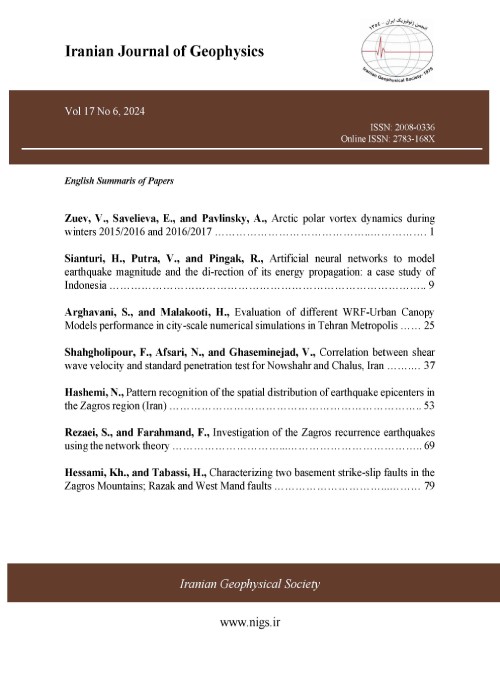Regional and optimal estimation of total electron content using pseudorange observations
Author(s):
Article Type:
Research/Original Article (دارای رتبه معتبر)
Abstract:
Total Electron Content (TEC) is one of the most important factors in monitoring the variable structure of ionosphere. Global Positioning System (GPS) is a useful and affordable instrument in TEC prediction through ground receivers. In this research, Vertical Total Electron Content (VTEC) is calculated in a GPS station using code observations and an approach is introduced for precise, and local modeling of this quantity. For doing this, a geometry-free combination of P1 and P2 observables is made and TEC for every satellite in an epoch is obtained using this combination and Differential Code Biases (DCB) of satellite and receiver. The calculated parameter shows total electron content in the direction of signal propagation in ionosphere layer. Besides, a mapping function is used for transforming TEC to VTEC. For doing this transformation, there are various mapping functions the common examples of which are geometric mapping function and empirical mapping function. In order to increase the precision and reduce systematic errors of calculations, the geometric mapping function is used. After calculation of VTEC for every satellite, it is necessary to obtain the amount of VTEC in zenith direction of the station. For doing this, a weighted function is used that inversely relates to the elevation angle of the satellite. The proposed weighted function provides an optimum and precise formula for calculation of VTEC in zenith direction of the station. In order to investigate the accuracy of calculations, all of the results are compared with the VTEC grids of International GNSS Service (IGS), and finally, the conclusions for every specific method are shown like weighted average, normal average and nearest vertex. In other words, IGS ionospheric products are considered as accurate and precise VTEC and the results are compared with these VTECs. As everybody knows, IGS VTECs are produced in a grid and thus, for calculation of VTEC in a specific point, mathematical approaches like weighted average of VTECs in surrounded vertexes of the point should be used. Conclusions illustrate the calculation of VTEC using proposed approach has a good adaption with the weighted average of VTECs around the Ankara grid station. The other results are also illustrated in diagrams. In addition, the periodic behavior of ionosphere at different times are also modeled, and the method is improved for optimum estimation of VTEC at various times. The only thing that is important is the local nature of this method, which is useful in one cell of IGS ionospheric network only.
Keywords:
Language:
Persian
Published:
Iranian Journal of Geophysics, Volume:11 Issue: 4, 2018
Pages:
54 to 66
magiran.com/p1806055
دانلود و مطالعه متن این مقاله با یکی از روشهای زیر امکان پذیر است:
اشتراک شخصی
با عضویت و پرداخت آنلاین حق اشتراک یکساله به مبلغ 1,390,000ريال میتوانید 70 عنوان مطلب دانلود کنید!
اشتراک سازمانی
به کتابخانه دانشگاه یا محل کار خود پیشنهاد کنید تا اشتراک سازمانی این پایگاه را برای دسترسی نامحدود همه کاربران به متن مطالب تهیه نمایند!
توجه!
- حق عضویت دریافتی صرف حمایت از نشریات عضو و نگهداری، تکمیل و توسعه مگیران میشود.
- پرداخت حق اشتراک و دانلود مقالات اجازه بازنشر آن در سایر رسانههای چاپی و دیجیتال را به کاربر نمیدهد.
In order to view content subscription is required
Personal subscription
Subscribe magiran.com for 70 € euros via PayPal and download 70 articles during a year.
Organization subscription
Please contact us to subscribe your university or library for unlimited access!


